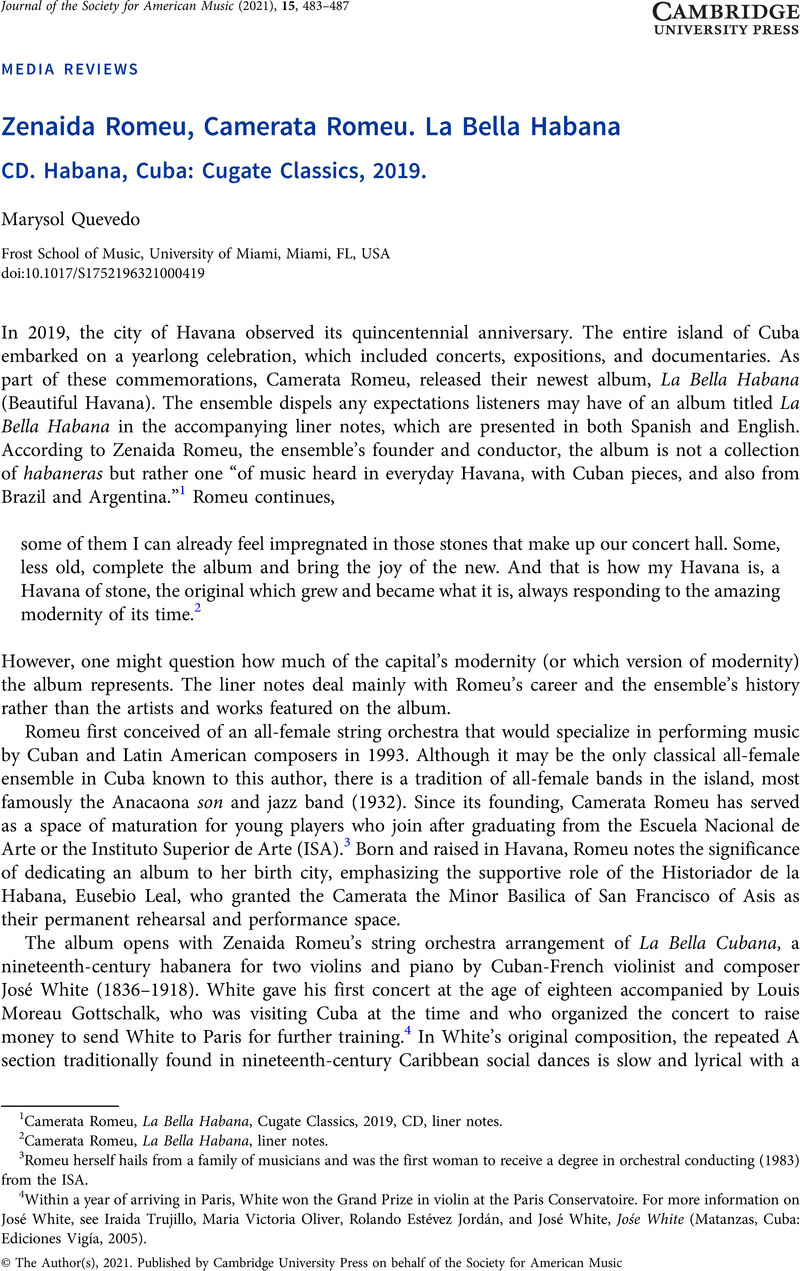No CrossRef data available.
Article contents
Zenaida Romeu, Camerata Romeu. La Bella Habana CD. Habana, Cuba: Cugate Classics, 2019.
Review products
Published online by Cambridge University Press: 22 December 2021
Abstract

- Type
- Media Review
- Information
- Copyright
- Copyright © The Author(s), 2021. Published by Cambridge University Press on behalf of the Society for American Music
References
1 Camerata Romeu, La Bella Habana, Cugate Classics, 2019, CD, liner notes.
2 Camerata Romeu, La Bella Habana, liner notes.
3 Romeu herself hails from a family of musicians and was the first woman to receive a degree in orchestral conducting (1983) from the ISA.
4 Within a year of arriving in Paris, White won the Grand Prize in violin at the Paris Conservatoire. For more information on José White, see Trujillo, Iraida, Oliver, Maria Victoria, Jordán, Rolando Estévez, and White, José, Jośe White (Matanzas, Cuba: Ediciones Vigía, 2005)Google Scholar.
5 The lyrics to “Chivo que rompe tambó” are told from the point of view of a Black Cuban who is searching for the goat (chivo) that has broken his drum (tambó or tambor). Throughout the song the speaker references Changó (the Orisha in Santería who rules over music) and tells listeners that he “doesn't like to perform animal sacrifices because he is a good Black man who is a child of Orula and Yemayá” (two other Orishas), but the goat has done something so reprehensible that it must pay with its own skin (traditionally consecrated batá drums used in Santería ceremonies are made with goat hide).
For more on hearing a Black/African sound in recorded music, see García, David F., Listening for Africa: Freedom, Modernity, and the Logic of Black Music's African Origins (Durham, NC: Duke University Press, 2017), 70, 78CrossRefGoogle Scholar.
6 “Curso de Violino Popular–Ricardo Herz,” Ricardo Herz: Violino Popular Brasileiro, accessed June 7, 2021, http://ricardoherz.com.br/curso-violino-popular/.
7 For a performance of Gil y Hamilton with Herz and the Camerata Romeu, see Ricardo Herz and Camerata Romeu, Gil e Hamilton, recorded live in Havana, July 2018, accessed June 28, 2021, https://www.youtube.com/watch?v=C7wKaMrhIZM.
8 Both of these genres were criticized as too bawdy and sensual when they gained popularity in the nineteenth century, and both incorporate syncopated bass lines attributed to Afro-diasporic influences. Chasteen, John Charles, National Rhythms, African Roots: The Deep History of Latin American Popular Dance (Albuquerque: University of New Mexico Press, 2004), 58, 136Google Scholar; Camacho, Jorge, “Espacios de con-tensión: el Yo, la danza y la literatura a finales del siglo XIX en Cuba,” Latin Americanist 48, no. 1 (2004): 59–71CrossRefGoogle Scholar.




